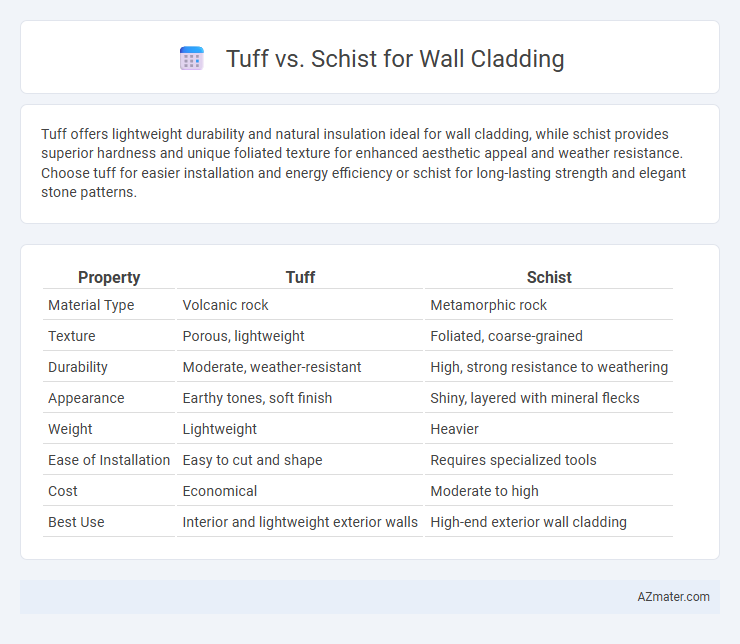Tuff offers lightweight durability and natural insulation ideal for wall cladding, while schist provides superior hardness and unique foliated texture for enhanced aesthetic appeal and weather resistance. Choose tuff for easier installation and energy efficiency or schist for long-lasting strength and elegant stone patterns.
Table of Comparison
| Property | Tuff | Schist |
|---|---|---|
| Material Type | Volcanic rock | Metamorphic rock |
| Texture | Porous, lightweight | Foliated, coarse-grained |
| Durability | Moderate, weather-resistant | High, strong resistance to weathering |
| Appearance | Earthy tones, soft finish | Shiny, layered with mineral flecks |
| Weight | Lightweight | Heavier |
| Ease of Installation | Easy to cut and shape | Requires specialized tools |
| Cost | Economical | Moderate to high |
| Best Use | Interior and lightweight exterior walls | High-end exterior wall cladding |
Introduction to Tuff and Schist as Wall Cladding Materials
Tuff, a volcanic rock formed from compacted volcanic ash, offers lightweight and porous characteristics ideal for wall cladding, providing excellent thermal insulation and ease of installation. Schist, a metamorphic rock known for its foliated texture and durability, delivers a natural, layered appearance with high resistance to weathering, making it a robust choice for exterior cladding. Both materials present distinct aesthetic and functional advantages, with Tuff excelling in insulation and lightweight properties, while Schist stands out for strength and textured elegance.
Geological Formation: Tuff vs Schist
Tuff forms from the consolidation of volcanic ash ejected during explosive eruptions, resulting in a porous and lightweight rock ideal for wall cladding with good insulation properties. Schist develops through regional metamorphism, characterized by its foliated texture and mineral alignment, offering a dense, durable surface with a distinctive layered appearance. The geological formation differences between tuff and schist influence their structural strength and aesthetic qualities, impacting suitability for exterior wall cladding applications.
Physical Properties Comparison
Tuff offers lightweight and porous characteristics with moderate compressive strength ideal for ease of installation in wall cladding. Schist provides higher density, greater durability, and superior resistance to weathering due to its foliated texture and mineral composition. Physical properties such as porosity, hardness, and tensile strength influence durability and maintenance requirements when selecting between Tuff and Schist for exterior or interior wall cladding applications.
Aesthetic Appeal and Color Variations
Tuff offers a softer, more homogeneous aesthetic with earthy tones ranging from pale gray to warm beige, creating a natural and subtle wall cladding effect. Schist provides a striking, textured appearance with pronounced layers and a broader palette, including greens, silvers, and dark grays, making it ideal for bold, dynamic designs. Both materials enhance architectural facades uniquely, but tuff suits minimalist styles while schist complements more dramatic, rugged looks.
Durability and Weather Resistance
Tuff offers exceptional durability and weather resistance due to its volcanic origin, making it highly resistant to erosion, freeze-thaw cycles, and moisture infiltration. Schist, while aesthetically appealing with its foliated texture, tends to be more susceptible to weathering and may require additional sealing to enhance its longevity in exterior wall cladding. For long-term performance and minimal maintenance in harsh climates, tuff is generally the preferred material over schist.
Installation Process and Techniques
Tuff offers easier installation for wall cladding due to its lightweight nature, allowing for quicker handling and reduced structural support requirements compared to schist. Schist requires precise alignment and specialized anchoring techniques because of its foliated texture and heavier weight, often necessitating experienced installers. Both materials benefit from mechanical fixing systems, but tuff's uniform thickness streamlines cutting and fitting, enhancing overall installation efficiency.
Maintenance Requirements
Tuff wall cladding requires minimal maintenance due to its dense, weather-resistant composition, making it less prone to erosion and staining compared to schist. Schist, being a foliated metamorphic rock with natural clefts, often demands more frequent cleaning and sealing to prevent moisture penetration and surface deterioration. Regular inspections and appropriate sealant applications are essential for schist to maintain its aesthetic appeal and structural integrity over time.
Cost Analysis: Tuff vs Schist
Tuff offers a more cost-effective solution for wall cladding due to its abundant availability and lower quarrying expenses compared to schist. Schist, with its layered texture and superior durability, commands higher prices influenced by labor-intensive extraction and processing methods. Budget-conscious projects often favor tuff for its economic benefits, while premium constructions might invest in schist's aesthetic and longevity despite the elevated cost.
Environmental Impact and Sustainability
Tuff and schist differ significantly in environmental impact and sustainability for wall cladding. Tuff, a volcanic rock, typically requires less energy for extraction and processing, resulting in a lower carbon footprint compared to the more energy-intensive quarrying and finishing of schist. The natural durability and insulation properties of tuff contribute to long-term sustainability by reducing maintenance needs and improving energy efficiency in buildings.
Best Applications and Design Recommendations
Tuff offers excellent thermal insulation and is ideal for rustic, natural-looking wall cladding in dry, temperate climates, making it suitable for exterior facades and garden walls. Schist provides durable, textured surfaces with high compressive strength, perfect for accent walls, fireplaces, and indoor feature walls requiring a sophisticated, layered aesthetic. Choose Tuff for lightweight, porous applications with good moisture resistance; opt for Schist when durability and a polished, natural stone finish are priorities in both interior and exterior designs.

Infographic: Tuff vs Schist for Wall Cladding
 azmater.com
azmater.com